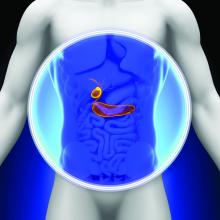SEATTLE – In patients with pancreatic cancer, an interval of 8 weeks between receiving neoadjuvant chemoradiation and surgical resection may improve resection margins, according to findings presented at the annual Society of Surgical Oncology Cancer Symposium.
The delay in resection did not negatively impact outcomes, and there was a modest improvement in overall survival among patients who had an 8-10 week interval between treatments.
“Attention should be focused on the treatment interval to time of resection in prospective studies,” said lead study author Raphael J. Louie, MD, of Dartmouth (N.H.) Hitchcock Norris Cotton Cancer Center.
Dr. Louie explained that for patients with pancreatic adenocarcinoma who receive neoadjuvant chemoradiation, it is unclear how long the optimal interval should be between therapy completion and surgical resection.
“Recent studies have suggested an improved tumor response with a longer interval from chemoradiation and surgical resection in rectal cancer,” he said.For this study, Dr. Louie and his colleagues sought to determine the optimal interval between neoadjuvant therapy and surgery to maximize response and oncologic outcomes.
“We hypothesized that there may be benefit to a delay,” he said.
The retrospective analysis included 637 patients who had been diagnosed with pancreatic adenocarcinoma at the Norris Cotton Cancer Center, and who had completed neoadjuvant chemoradiation and underwent R0 surgical resection between Jan. 1, 2004, and Dec. 31, 2015.
Of this group, 195 patients had metastatic disease, 28 underwent upfront surgical exploration, and 94 were lost to follow-up or had a poor performance status and were not included in the final analysis.
The cohort was grouped according to time from chemoradiation completion to surgery: 6-8 weeks, 8-10 weeks, and more than 10 weeks.
A total of 320 patients received neoadjuvant chemoradiation and 288 completed the full course. Of this group, 128 were evaluable by pathologic review.
Among patients with a 6- to 8-week interval, 61% had an R0 resection margin. This percentage rose to 72% for those who had an 8- to 10-week interval, and in similar fashion, 70% for those who had a 10- to 13-week interval (P = .6)
However, there was no statistical difference when the three groups were compared collectively.
Of 26 patients who were resected within 6-8 weeks of chemoradiation, 11% achieved a complete response (CR), 27% had a partial response (PR), and 61% had recurrence for an average disease-free survival of 20 months.
In the group (n = 58) of patients who were resected within 8-10 weeks, 7% had CR, 71% had PR, and 62% had recurrence, for an average disease-free survival of 17 months. Finally, the 44 patients who were resected within 10-13 weeks had similar outcomes; 5% had CR, 61% had PR, and 61% of patients had recurrence for an average disease-free survival of 14 months.
Dr. Louie noted that even though they observed improved PR in the 8- to 10-week group, there was no statistical significance in disease-free survival (P = .71) or overall survival (P = .19).
“Allowing more time from neoadjuvant therapy completion to surgical resection may improve the pathologic response,” said Dr. Louie. “Larger studies are needed to determine if the time interval to surgical resection has oncologic benefit for these patients.”
Dr. Louie has no disclosures.

